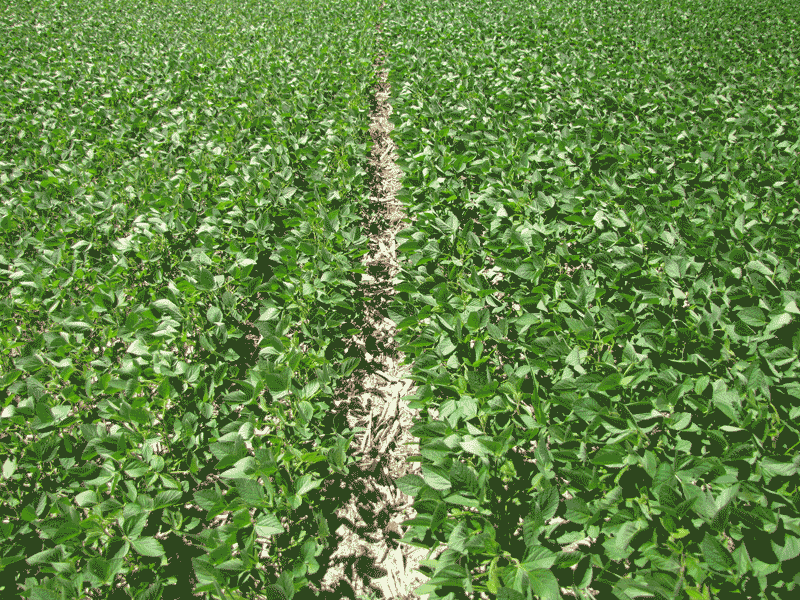Do high yielding soybeans need nitrogen fertilizer?
CURRENT AND FUTURE RESEARCH ON SOYBEANS AND FERTILIZER
SOYBEANS REQUIRE A tremendous amount of nitrogen to achieve high yields — a 50 bushel per acre crop will remove 200 pounds per acre of nitrogen. Despite soybeans’ ability to fix atmospheric nitrogen, the plant does take a large amount straight from soil reserves. Forty to 75 percent of the nitrogen comes from the soil, not through fixation.
Soybeans require the greatest amount of nitrogen during pod fill and seed stages in late July and August. Unfortunately, this is also the time when water becomes limiting and under dry conditions, fixation from the air is slowed and can even stop. Even if moisture is not limiting, fixation from the atmosphere may not be able to keep up with demand for crops over 60 bushels per acre.
challenges with commercial fertilizer
The most obvious answer to the problem of limited nitrogen during these important crop stages is the application of commercial fertilizer. Unfortunately, plants will use the most available nitrogen first and stop fixing nitrogen when commercial nitrogen is available and, if applied early, it can hinder nodulation formation altogether. Applying commercial fertilizer seems to simply replace “free” nitrogen the plant would take from the atmosphere with fertilizer.
There can also be additional problems when adding nitrogen fertilizer. Excessive vegetative growth, plant lodging and white mould are often seen when large amounts of commercial nitrogen fertilizer are applied to soybeans.
Hundreds of experiments have been conducted to study the impact of applying nitrogen fertilizer at different growth stages to achieve more yield and results so far have been very inconsistent. In a few situations, pre-plant nitrogen applications have increased yield. These situations seem to be with very low soil organic matter, low inorganic nitrogen supply, low residual soil nitrate, or very dry conditions. Out of 10 studies in Minnesota only two showed a yield increase. Yield was increased when soil nitrate was very low, there was a low yield potential, a short season or soil conditions that limited nodulation. Under normal growing conditions no yield was gained by adding nitrogen.
One approach we tried was to deep band ESN (slow release nitrogen) six to eight inches below the row at planting time. The concept was that soybeans would nodulate normally during the first part of the growing season before the root accessed the commercial fertilizer. When demand for nitrogen increased and surface conditions dried up in mid summer the roots would reach the deep banded ESN to supply the plant. The idea was to have the plant both fix nitrogen from the atmosphere and use commercial fertilizer. We applied 100 pounds per acre of actual nitrogen as ESN at five large scale replicated sites. The yield results were so disappointing that we decided there was little point in pursuing deep banded nitrogen trails further (see Table 1).
TABLE 1. SOYBEAN RESPONSE TO DEEP BANDED ESN AT SEEDING TIME
| Untreated | 100 lbs ESN (6″ depth) | |
| Average Yield Response | 49.9 bu/ac | 50.6 bu/ac |
| Soybean yield response of 5 replicated trials conducted in Wellington, Middlesex, Kent, Perth and Elgin counties in 2009. | ||
exploring other options
Since demand for nitrogen spikes at the pod stage (R3), recent work has focused on applying nitrogen at this timing. Fifty-six trials conducted in Nebraska showed yield increases of 2.5 bushels per acre in south central Nebraska with 27 pounds per acre of nitrogen applied. The increase was 1.6 bushels per acre in the northeast and none in southeast Nebraska. These results were found when yields were greater than 60 bushels per acre. Applying 54 pounds per acre of nitrogen compared with applying 27 pounds per acre or when adding 4.5 pounds per acre of sulphur did not add more yield. These results agree with other studies that have found applying nitrogen at the R3 growth stage is only likely to increase yields in fields that yielded greater than 60 bushels per acre. If yields are less than 60 bushels per acre achieving an economic yield response to nitrogen has been extremely difficult to achieve, even with this in season application.
potential interactions
Although application of commercial nitrogen has not worked out so far, there may be situations where it could add to yield. In 2011 we set up a number of experiments to see if applying slow release nitrogen at seeding time along with sulphur will provide economic yield benefits in combination with other factors. For example, is the nitrogen response greater when using higher plant populations and foliar fungicides? Sulphur deposition has decreased in Ontario over the years and research has shown results with canola and wheat. The combination of slow release nitrogen along with some sulphur in combination with other inputs may add yield.
We are also testing nitrogen fertilizer in no-till fields with heavy corn residues to see if a lack of nitrogen is part of the problem with early growth in no-till. It has been observed that plants look healthier and a darker green colour early in the season when applying nitrogen fertilizer.
PHOTO: THE RIGHT SIDE HAD NITROGEN AND SULPHUR APPLIED, THE LEFT SIDE IS CONTROL.

To date, the research does not support applying nitrogen fertilizer to soybeans. When it comes to nitrogen, the most consistent economic benefits have come from using a good inoculant to help the plant fix “free” nitrogen from the atmosphere. •







